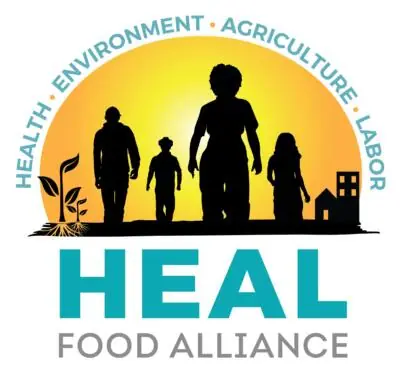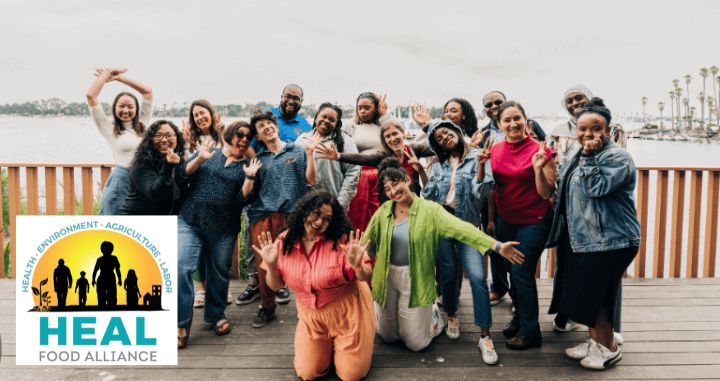By Elizabeth Tobey
 HEAL Food Alliance is a multi-sector, multi-racial coalition dedicated to transforming food and farm systems through policy, education, and grassroots support. With nearly 60 member organizations, HEAL is focused on protecting farm and food system workers, advocating for climate justice, and supporting BIPOC-led organizations. HEAL stands for Health, Environment, Agriculture, Labor, and the Alliance was born out of the understanding that no single individual, organization, or sector can transform systems in isolation.
HEAL Food Alliance is a multi-sector, multi-racial coalition dedicated to transforming food and farm systems through policy, education, and grassroots support. With nearly 60 member organizations, HEAL is focused on protecting farm and food system workers, advocating for climate justice, and supporting BIPOC-led organizations. HEAL stands for Health, Environment, Agriculture, Labor, and the Alliance was born out of the understanding that no single individual, organization, or sector can transform systems in isolation.
Nichelle Harriott is the Policy Director at HEAL, and also serves on OFRF’s board of directors. She recently gave a presentation to OFRF staff and board members about HEAL’s work, as part of a series of “Lunch and Learn” events that OFRF is coordinating to build stronger connections between our organization and others working in the food and agriculture sectors. Here are our key takeaways from meeting with Nichelle and learning about the powerful work that HEAL is doing.
How It Started
HEAL began around 2016, when four organizations came together at a conference and started talking about the intersection of health, environment, agriculture, and labor. Those four organizations were Real Food Generation, National Black Food and Justice Alliance, Union of Concerned Scientists, and Food Chain Workers Alliance. From that initial conversation, HEAL was born and has since grown to over 60 member organizations, consisting mostly of local groups with a few regional and national organizations involved as well.
How It’s Going
As Nichelle put it, “HEAL believes that everyone has the right to have access to foods that are nutritionally and culturally appropriate, free from exploitation, and grown in harmony with the rest of the natural world.”
The Alliance utilizes five core methods for conducting their work to achieve this vision:
Connecting and uniting groups
As an alliance of member organizations, HEAL focuses on connecting groups to leverage and support each other in creating effective change. All members play a guiding role by identifying and uplifting priority issues for HEAL to advocate around. Core Members are BIPOC-led or BIPOC-serving, while Connecting Members include others who align with HEAL’s mission. The four founding organizations continue to play a key role within HEAL, as part of the membership and serving on the steering committee.
HEAL supports members through regranting programs. Earlier this year, they were able to regrant $400K to 26 members facing budget gaps due to the federal funding freeze in early 2025. Annually, they provide approximately $50K in rapid response funds to support smaller, less-resourced members.
Political education and analysis

The School of Political Leadership team in San Diego. Photo credit HEAL Food Alliance.
HEAL facilitates the School of Political Leadership (SOPL), a three-month program to equip young leaders with policy and advocacy skills. Made up of a mix of virtual and in-person sessions, this program includes lobbying experience in Washington, D.C. As of our conversation in mid-2025, SOPL has graduated over 10 cohorts of young political leaders and advocates with the training needed to effectively advocate for a future they believe in.
In their policy work, HEAL prioritizes worker protections, climate justice, corporate consolidation, and support for BIPOC producers. They focus on federal-level policy, especially the Farm Bill, and held their first Congressional briefing on workers and the Farm Bill in 2023.
Advancing a shared narrative
The communications team at HEAL Food Alliance is intentional about how they tell their stories, ensuring that messaging around priority issues aligns with a Race Class Narrative (RCN) framework. This framework prioritizes telling stories that unify rather than divide people across class and race, and build power to take on corporate and political entities that historically and currently seek to divide and exploit us. Their “Rooted, Ready, & Resilient: Uplifting a BIPOC-led Vision for Crisis-Proof Food Systems” guide, developed during the COVID-19 pandemic, is a great example of this strategic and purposeful work.
Connecting and nurturing existing and emerging campaigns
HEAL is currently working on a narrative of abundance messaging guide for members, to challenge the false narrative that there is not enough to go around. “Scarcity is manufactured by those in power,” Nichelle explained. HEAL is working to flip that script, showing what’s possible when we move from a mindset of scarcity to a one of abundance. They are promoting the message that we can and should choose policies that reflect what is possible when we invest in people, not corporations.
Ensuring underserved communities have the resources they need to bring about grassroots change
Nichelle discussed the impact that discrimination and exploitation have on Black and brown communities. Addressing this is a foundational and ongoing priority area for HEAL’s work. For instance, they have worked extensively with Senator Booker (D–NJ)’s office on campaigns to improve working conditions of meatpacking workers. They are also engaged in advocating for heat stress protections and immigration reform for farmworkers. HEAL is unique in that they focus on food and farm workers across supply chains, including in farm fields, processing facilities, and restaurants. Their goal is to help shape policy that “safeguards those that grow, harvest, and serve the foods that we rely on,” as Nichelle said.
Collaboration Opportunities
Recognizing the strength in collaborative efforts, Nichelle pointed to several areas where HEAL is open to connecting with other food and agriculture organizations. She noted the messaging work they are doing around abundance, and invited organizations such as OFRF to incorporate that framework into their communications. Another area she noted as important to continue to highlight is the connection between climate change and agricultural communities.
Next Steps
To learn more about the work that HEAL Food Alliance is doing, visit their website at https://healfoodalliance.org/. If you’re ready to jump in and get involved, head straight for their Take Action page, where you can Join the Alliance, Connect, Explore, or Support. You can scroll to the bottom to sign up for their newsletter and follow them on social media to stay in the loop.



